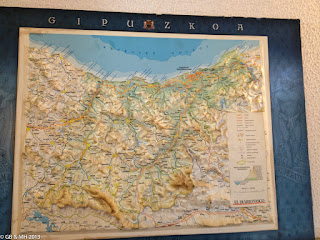Billy and I sauntered along San Sebastian’s
famed La Conche beach, joining the locals out on their brisk morning walks with
their dogs. The air felt icy, but it was sunny and that made me feel warm (that
and the 20kgs in my pack).
 |
| La Concha Beach, start of our Basque hike |
A group of older women tentatively ventured
out for a swim. A few held their arms up above the waterline as they slowly
submerged.
I instinctively shivered - I know that
move! It’s how I approach entering the water at Coogee Beach in July.
 |
| This guy was enjoying the beach too! |
The beach was lined with older style white
apartment blocks standing quiet in the offseason. I could only imagine the
energy that burst forth on a summer’s morning on one of Europe’s best known
beaches, like Bondi on a hot public holiday.
 |
| Scenic views |
I went around to the El Peine de Los Vientos (The Comb of the Winds) sculptures whilst
Billy checked the map, then we headed up the winding road to Mount Igueldo.
 |
| El Peine de Los Vientos (The Comb of the Winds) |
A concerned driver stopped to check we knew
where we were going – most people take the funicular, or avoid this mountain
and take the camino track. Then he saw my camera dangling around my neck and
waved us on, “beautiful views, you must see,” he cried.
We paid our E$2.20 each to “access company
roads”, reached the castle atop the mountain and looked down on San Sebastian.
The waves entering the bay made curved lines as they passed through the narrow
inlet. We watched a sea kayak paddle across the lines unhindered. The sun shone
soft through the slightly hazy sea air. What a great place to be!
 |
| Views of San Sebastian |
The lookout was a bit curious. A silent,
small amusement park stood next to the “mountain of terror” with a gorilla face
and dinosaur sign. It somewhat marred a place where natural beauty was
sufficient entertainment.
We put this behind us, and started looking
for the familiar red and white signs of the GR.
 |
| GR 121, the road less travelled |
After a short while along the road we took
a turn onto the road less travelled. A dirt single trail that wound its way
along the coastline.
The views were stunning. Sharp, dark rock
jutted out of the ocean. The landscape filled with brilliant green pastures
encouraged by the frequent storms that cross the Bay of Biscay that dump their
loads on the rising Basque coastline.
 |
| Slopes into the Bay of Biscay |
The road less travelled sounds romantic
until you find yourself slipping down in the mud, ducking beneath old bracken
and being stabbed by vicious spiky plants.
 |
| Killer plants |
Everything here wants to attack you. I had
prickles starting dreadlocks in my hair, and branches reaching out and grabbing
any rough surface on my pack. It was wild and unkept, but beautiful too.
 |
| Billy forges a path through the brambles |
We lost the track a couple of times and
ended up following the fence lines of pastures. A group of donkeys brayed at us
as we went to take their trail. Sheep looked up curiously as we passed.
 |
| Hello donkey |
 |
| Ears only a mother could love |
It wasn’t just the plants that had it in
for us.
At one point, the GR 121 followed along the
inside border of an old property with a nearby farmhouse. We could hear a dog
start barking in the distance, and reached for a few pebbles in defence.
The barking increased and I saw a ball of
gold and black fur accompanied by a set of razor sharp teeth launch down the
slope above. It happened so quickly, but felt like slow motion.
I stood, waiting for the dog to realise I
wasn’t a threat and stop. It didn’t.
Suddenly it was a few metres away and
looking to launch up at my throat.
Billy was yelling and waving his fist. I
finally found my voice too. Luckily it was sufficiently confused to hesitate
for a second and I moved a few meters.
The owners came out and started yelling for
it to retreat. I took a deep breath.
Yikes. Scary. Billy called out, “esta
bien?” “Is it good?” We watched the owner try to calm the dog down. We quickly
passed through the property and out of reach. They don’t mention these moments
in the guide books!
We stopped for a snack of gourmet Ortiz
sardines, fresh tomato and pan. The sun was already low in the sky, even though
it was only 3pm.
 |
| Lunch! |
We’d walked about 8km. Not far, but a late
start and the morning deviations to the lookout added up. We weren’t going to
make the small town of Orio, next along the trail, so started looking out for
campsites.
Billy had spotted a possible location on
the map – a ridge just before the town. It looked doubtful as we continued to
weave between the brambles on the steep slopes.
We made a final climb alongside a small
stream and lucky for us came across a beautiful grassy spot. Perfect for a fire
and a tent.
 |
| The perfect place to spend the night |
Time to relax and enjoy the view west
towards the lights of Zaurutz, the next big town along the coast.


